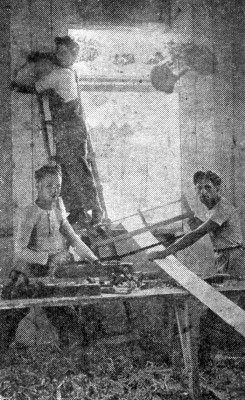
|
from Rayvits at work in Israel:
Shmuel Erlichman, Yakov Foyglfooss
and Israel Zilber
|
|
[Page 179]
|
|
| The first three pioneers (Halutzim) from Rayvits at work in Israel: Shmuel Erlichman, Yakov Foyglfooss and Israel Zilber |
|
The Committee in particular takes care of the Rayvits New Immigrants helping them to settle down. However, the most interesting point of the Rayvits Organization's activity is the fact in which it differs from other villages: The Rayvits Favors Fund consists from Israel members' donations only, without help from abroad. However, there is not a rule without exception. Mr. Manus Tsederbaum from Canada was our exception. He gathered among his local landsleyt 180 (One Hundred and eighty) Israeli pounds and sent it to our Committee. We are thanking him very much and we ask him to continue his blessed activity in behalf of the Rayvits Organization. We ask all our Landsleit Organizations abroad to assist us with important money sums for the New Olim (new comers) from Rayvits.
Should it be the pangs of redemption, the pain of birth? How much strength should we have to overpower the vigor of our Sages of blessed memory R' Yohanan, R' Olan and Rabhan, who when hearing the Messiah's steps, announced, “Should he come and I will not see him!” Would we be stronger as the three? Our answer is yes--because the despair call of the three we had already absorbed inside our soul long ago and with this scream we strode over our greatest destruction to the State of Israel where we will take out from the spoiled garbage the human image of God and we will clean it out with “Isroel”(Israel) and in unity with “The Entire Isroel”.
Therefore, we had heard the unheard and we have seen the unseen. Moreover, with clean hearted heartiness we had heard the last “Shmah Isroel”(Hear us Israel) said by those who strode for us to Sacrifice.
Would those pages be a memorial tombstone on our holy Rayvits Congregation's Graveyard without graves? Would they start the payoff of our debt to them. Our children and grandchildren should know that only with holiness should they approach the Holy martyrs.
Therefore, this Tombstone should be in each house where a Rayvits person lives, in order to fulfill the Pentateuch testament “Remember what Amalek had done to you!” It is not only a testament but a permanent revenge war as our Torah did command: “Fight Amalek from generation to generation for God's name!”
Comfort, comfort yourself, my people!
[Page 180]
Rayvits
By Gad Zaklikovski
Translated by Moshe Porat
|
|
| Gad Zaklikovski | |
Rayvits, which was a most religious community, differed from other similar shtetls by the lack of quarrels between elderly and young inhabitants. There were some minor disputes but never a serious quarrel.
For this reason, the young Rayvitsers were not embittered against the adults and did not attack them with sophisticated irritations. Both sides established friendly relations between them. So, when it became necessary to reconstruct the school, which the Russians destroyed during the First World War, the Zionist organization, which gathered many “free” (not religious) young inhabitants, initiated and provided the financial means to accomplish the work.
Therefore, pious parents sent their children to study in the Zionist school, not the religious school, where the teachers did not emphasize secularism.
Here I would like to explain the current saying “Silence like in Rayvits” (which Yizchak Leyboosh Peretz' mentioned in his novels). Historically this saying has a relation with Chmelnitski's pogroms in the 17th century. For some reasons the town did not suffer during those killings. Therefore, when one wanted to refer to a quiet shtetl, he would say, “this place is quiet like Rayvits”.
However, there were different explanations. The old R' Motl Zonshein told me once that it comes from the great discussion between Izbishitse and Kotsk “an almost bloody quarrel” about an azure string “Techelet” in the Taless Koton (four fringed garment). When someone wanted to speak with irony about a false quietness of a noisy shtetl, would he say “Quiet like in Rayvits”. Therefore, the quietest town in Lublin district obtained this bad nickname because of a quarrel between two pious parties.
Another explication was told to me by a local patriot of Chelm. “Such as on the way to Chelm one must pass Rayvits, and the Chelmer are full with wisdom and as the limit of wisdom is silence; therefore Rayvits' silence is guarding Chelm's cleverness. For this reason was born the saying “Quiet like in Rayvits”. Let it be so!
|
|
| Sarah Appletzvoyg, Boshe Shenker, Freyde Ziglboym, Zisha Doblman, Hadassah Mints, Volfish Epstein, Sarah Shmuklerman Photo taken in 1922 on the Aliya of Gad Zaklikovski |
|
|
|
JewishGen, Inc. makes no representations regarding the accuracy of
the translation. The reader may wish to refer to the original material
for verification.
JewishGen is not responsible for inaccuracies or omissions in the original work and cannot rewrite or edit the text to correct inaccuracies and/or omissions.
Our mission is to produce a translation of the original work and we cannot verify the accuracy of statements or alter facts cited.
 Rayvits descendants in the State of Israel
Rayvits descendants in the State of Israel
 Yizkor Book Project
Yizkor Book Project
 JewishGen Home Page
JewishGen Home Page
Copyright © 1999-2025 by JewishGen, Inc.
Updated 4 Oct 2005 by LA